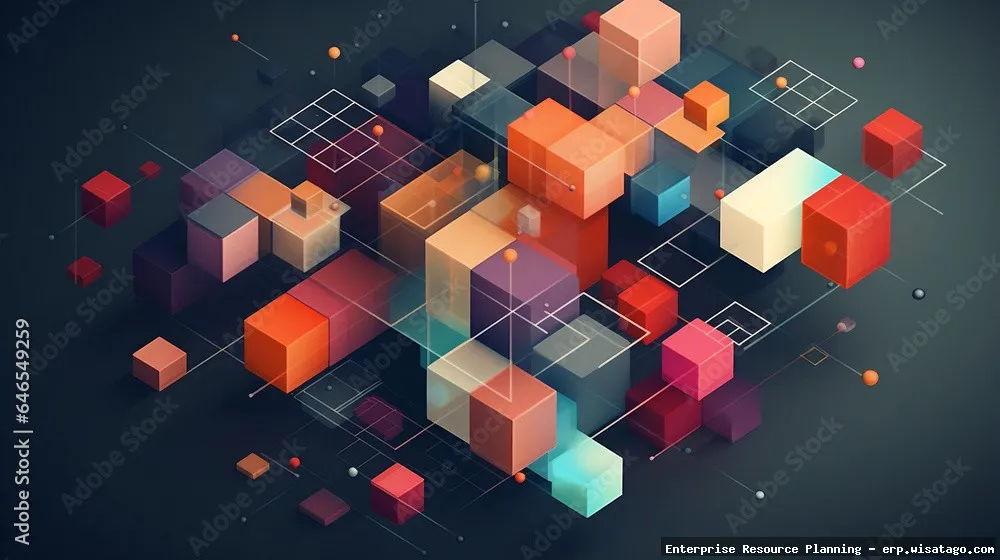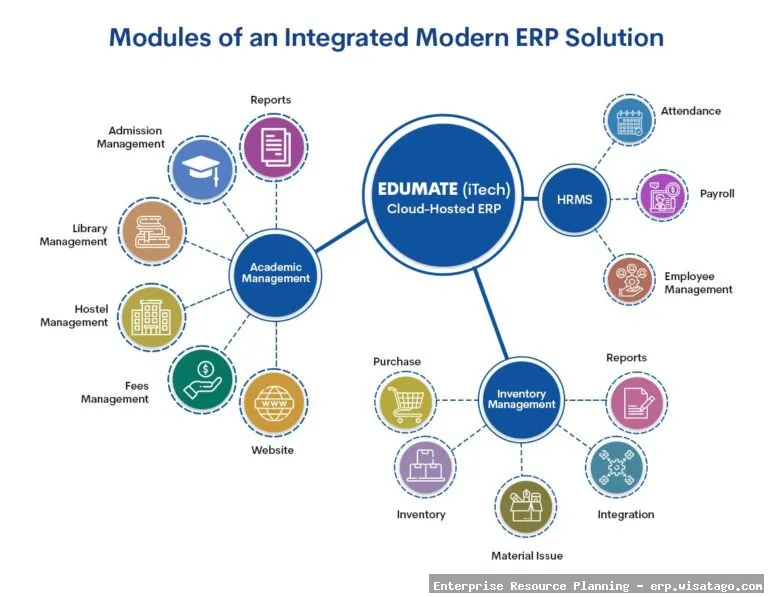Microservices Architecture In Modern ERP Design: Complete Guide, Features and Details
Enterprise Resource Planning (ERP) systems have become the backbone of modern businesses, integrating various functions like finance, human resources, supply chain, and customer relationship management into a unified platform. However, traditional monolithic ERP systems, while comprehensive, often suffer from rigidity, complexity, and high maintenance costs. As businesses evolve and demand greater agility and scalability, the limitations of these monolithic architectures become increasingly apparent. This is where microservices architecture steps in, offering a compelling alternative for modern ERP design.
Microservices, in essence, decompose a large application into smaller, independent, and loosely coupled services. Each service focuses on a specific business capability and can be developed, deployed, and scaled independently. Applying this architectural style to ERP systems allows for greater flexibility, resilience, and faster innovation cycles. Instead of a single, massive codebase, an ERP system built on microservices comprises numerous smaller services interacting through well-defined APIs. This modular approach unlocks a new level of adaptability, enabling businesses to tailor their ERP systems to their unique needs and adapt quickly to changing market conditions.

This article delves into the world of microservices architecture in modern ERP design. We’ll explore the benefits of this approach, the key features that differentiate it from traditional ERPs, the challenges associated with its implementation, and provide practical insights for businesses considering adopting a microservices-based ERP solution. By understanding the nuances of this architectural paradigm, businesses can make informed decisions about their ERP strategy and unlock the full potential of a modern, agile, and scalable enterprise resource planning system.
Microservices Architecture In Modern ERP Design: Complete Guide, Features and Details
Traditional ERP systems are often built as monolithic applications, meaning all functionalities are tightly integrated into a single codebase. While this approach offers a centralized view of the business, it also creates significant challenges in terms of maintenance, scalability, and innovation. Microservices architecture, on the other hand, provides a more flexible and agile approach to ERP design.
What is Microservices Architecture?
Microservices architecture is a software development approach that structures an application as a collection of small, autonomous services, modeled around a business domain. Each service is responsible for a specific business function, such as order management, inventory control, or customer billing. These services communicate with each other through lightweight mechanisms, often an HTTP resource API. Key characteristics of microservices include:
- Single Responsibility: Each service focuses on a specific business capability.
- Independent Deployment: Services can be deployed and updated independently without affecting other services.
- Decentralized Governance: Teams have autonomy in choosing the technologies and languages best suited for their service.
- Fault Isolation: Failure in one service does not necessarily bring down the entire system.
- Scalability: Individual services can be scaled independently based on demand.
Benefits of Microservices in ERP
Adopting a microservices architecture for ERP offers several compelling benefits over traditional monolithic systems:
Increased Agility and Flexibility
Microservices enable faster development cycles and quicker response to changing business needs. New features can be developed and deployed independently without requiring a complete system overhaul. This agility allows businesses to adapt to market trends and customer demands more effectively.
Improved Scalability and Performance
Individual services can be scaled independently based on their specific resource requirements. This allows for efficient resource utilization and optimized performance, especially during peak seasons or periods of high demand. For example, the order management service can be scaled up during a promotional period without affecting the performance of the finance module. For more information, you can refer to ERP as an additional resource.
Enhanced Resilience and Fault Tolerance
Since services are loosely coupled, a failure in one service is less likely to cascade and bring down the entire system. This improves the overall resilience and availability of the ERP system. Robust error handling and monitoring mechanisms can be implemented to detect and mitigate failures quickly.

Technology Diversity and Innovation
Microservices allow teams to choose the best technologies and languages for their specific services. This fosters innovation and enables the adoption of cutting-edge technologies without being constrained by the limitations of a monolithic architecture. Different teams can use different databases, programming languages, and frameworks based on their needs and expertise.
Easier Maintenance and Updates
Smaller codebases are easier to maintain and update. Deploying updates to a single service is less risky and less disruptive than deploying updates to a large monolithic application. This simplifies maintenance tasks and reduces the risk of introducing bugs during updates.
Key Features of a Microservices-Based ERP
A microservices-based ERP system will typically exhibit the following key features:
API-First Design
All services communicate with each other through well-defined APIs. This ensures loose coupling and allows for easy integration with other systems. APIs are the contract between services, defining how they interact and exchange data.
Decentralized Data Management
Each service typically has its own database, allowing for data independence and optimized data storage. This avoids the limitations of a single, centralized database and enables each service to choose the database technology that best suits its needs. Data consistency can be managed through eventual consistency patterns.
Automated Deployment and Orchestration
Automated deployment pipelines and container orchestration platforms (e.g., Kubernetes) are essential for managing and deploying a large number of microservices. These tools automate the deployment process, ensure consistent environments, and provide scaling and monitoring capabilities.
Centralized Logging and Monitoring
A centralized logging and monitoring system is crucial for tracking the performance and health of all services. This allows for quick detection and diagnosis of issues, ensuring the overall stability of the ERP system. Tools like Prometheus and Grafana can be used for monitoring, while Elasticsearch, Logstash, and Kibana (ELK stack) can be used for logging.

Security Considerations
Security is paramount in a microservices architecture. API gateways and authentication mechanisms are necessary to secure access to services. Consider implementing OAuth 2.0 or similar protocols for authentication and authorization. Also, implement robust security measures for inter-service communication.
Challenges of Implementing Microservices in ERP
While microservices offer significant advantages, implementing them in an ERP system also presents several challenges:
Increased Complexity
Managing a large number of independent services can be complex. DevOps practices, automated deployment pipelines, and robust monitoring systems are essential for managing this complexity. The distributed nature of microservices also makes debugging and troubleshooting more challenging.
Data Consistency
Maintaining data consistency across multiple databases can be challenging. Eventual consistency patterns and distributed transaction management techniques may be required. Careful consideration must be given to data synchronization and conflict resolution.
Communication Overhead
Inter-service communication can introduce overhead and latency. Efficient communication protocols and caching strategies are important for minimizing this overhead. Consider using asynchronous messaging queues like Kafka for inter-service communication.
Organizational Changes
Adopting a microservices architecture often requires significant organizational changes. Teams need to be organized around business capabilities and empowered to make independent decisions. A DevOps culture is essential for successful microservices implementation.
Security
Securing microservices requires a robust security strategy, including authentication, authorization, and encryption. API gateways and service meshes can help enforce security policies and manage access control.

Practical Considerations for ERP Adoption with Microservices
Before embarking on a microservices-based ERP implementation, consider the following:
Start Small and Iterate
Don’t try to migrate the entire ERP system to microservices at once. Start with a small, non-critical module and gradually migrate other modules over time. This allows you to learn from your experiences and refine your approach.
Invest in Automation
Automation is crucial for managing the complexity of a microservices architecture. Invest in automated deployment pipelines, monitoring tools, and testing frameworks.
Choose the Right Technologies
Select technologies and tools that are well-suited for microservices development and deployment. Consider using containerization technologies like Docker and orchestration platforms like Kubernetes.
Focus on Domain-Driven Design
Use domain-driven design (DDD) principles to model your services around business capabilities. This will ensure that your services are well-defined and loosely coupled.
Establish Clear Communication Channels
Effective communication is essential for coordinating the efforts of multiple teams working on different services. Establish clear communication channels and encourage collaboration.
Conclusion
Microservices architecture offers a powerful approach to modern ERP design, providing increased agility, scalability, and resilience. While implementing microservices presents challenges, the benefits often outweigh the risks, especially for businesses that require a flexible and adaptable ERP system. By carefully considering the challenges and adopting best practices, businesses can successfully leverage microservices to build a modern, agile, and scalable ERP solution that meets their evolving needs.

The transition to microservices-based ERP is not just a technological shift; it’s a cultural and organizational transformation. It requires a commitment to automation, collaboration, and continuous improvement. However, the rewards are significant: a more responsive, resilient, and innovative ERP system that can drive business growth and competitive advantage.
Ultimately, the decision to adopt a microservices architecture for ERP depends on the specific needs and priorities of the business. However, for organizations seeking greater agility, scalability, and innovation, microservices offer a compelling alternative to traditional monolithic ERP systems. By carefully evaluating the benefits and challenges, and by following best practices for implementation, businesses can unlock the full potential of a modern, microservices-based ERP solution.
Conclusion
In conclusion, the integration of microservices architecture into modern ERP design represents a significant evolution, offering a pathway towards greater agility, scalability, and resilience. By decoupling monolithic ERP systems into independent, specialized services, organizations can achieve unprecedented flexibility in adapting to evolving business needs and technological advancements. Throughout this article, we’ve explored the key benefits of this architectural shift, including enhanced fault isolation, improved development velocity, and the ability to leverage best-of-breed technologies for specific business functions. The transition, however, is not without its challenges, requiring careful planning, robust monitoring strategies, and a commitment to DevOps principles.
Ultimately, the decision to adopt a microservices-based ERP architecture hinges on a company’s specific requirements and long-term strategic goals. While the initial investment may seem substantial, the long-term gains in terms of adaptability and reduced maintenance costs can be considerable. As businesses increasingly demand customized and responsive solutions, the microservices approach presents a compelling alternative to traditional, rigid ERP systems. If you’re considering modernizing your ERP landscape, we encourage you to explore the possibilities offered by microservices and assess how this innovative architecture can empower your organization to thrive in today’s dynamic business environment. Explore our website further or contact us to learn how we can help you navigate this transformative journey and unlock the full potential of a microservices-driven ERP strategy.
Frequently Asked Questions (FAQ) about Microservices Architecture in Modern ERP Design
What are the key benefits of adopting a microservices architecture in Enterprise Resource Planning (ERP) systems, and how does it differ from a traditional monolithic ERP?
Adopting a microservices architecture in ERP systems offers several key benefits compared to traditional monolithic ERPs. One major advantage is increased agility and flexibility. Each microservice is a small, independent unit, allowing for faster deployment, updates, and scalability. This contrasts sharply with monolithic ERPs, where even minor changes require redeployment of the entire system, leading to significant downtime and risk. Microservices also enhance fault isolation; if one microservice fails, it doesn’t necessarily bring down the whole ERP. Furthermore, microservices enable technology diversity, allowing development teams to choose the best technology stack for each specific service, whereas monolithic ERPs often lock you into a single technology. Finally, microservices allow for independent scaling of individual components, leading to better resource utilization and cost efficiency.
How can my organization successfully migrate from a monolithic ERP system to a microservices-based ERP architecture, and what are the potential challenges during the migration process?
Migrating from a monolithic ERP to a microservices-based architecture is a complex undertaking that requires careful planning. A common approach is the strangler fig pattern, gradually replacing monolithic functionalities with microservices. Start by identifying independent modules within the existing ERP that can be extracted and re-architected as separate microservices. Focus on building new features as microservices rather than modifying the monolith. A critical step is establishing robust APIs for communication between the existing monolith and the new microservices. Potential challenges include managing data consistency across distributed microservices, ensuring proper security and authentication, and dealing with increased operational complexity due to the distributed nature of the system. Thorough testing and monitoring are essential throughout the migration process, along with strong collaboration between development, operations, and business teams. Invest in DevOps practices and automation to streamline deployment and management.
What are the key considerations for securing a microservices-based Enterprise Resource Planning (ERP) system, and what security best practices should be implemented?
Securing a microservices-based ERP presents unique challenges due to its distributed nature. Key considerations include securing inter-service communication, managing authentication and authorization across multiple services, and protecting sensitive data at rest and in transit. Implement API gateways to control access to microservices and enforce security policies. Use mutual TLS (mTLS) for secure communication between services, ensuring that both the client and server are authenticated. Employ OAuth 2.0 or OpenID Connect for authentication and authorization, enabling fine-grained access control. Implement robust data encryption techniques, both at rest and in transit, using technologies like AES-256. Regularly perform security audits and penetration testing to identify vulnerabilities. Implement centralized logging and monitoring to detect and respond to security incidents promptly. Adopt a zero-trust security model, assuming that no user or service is inherently trusted, and requiring verification for every access request.